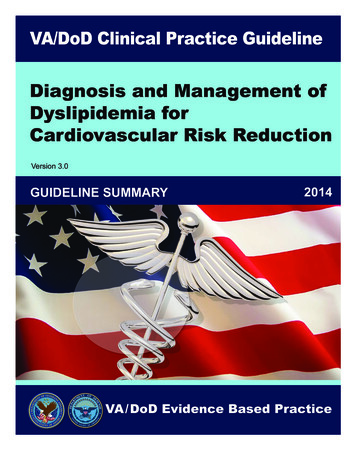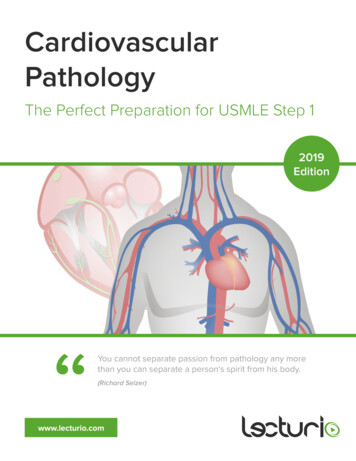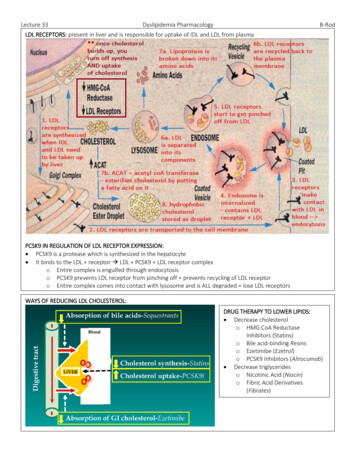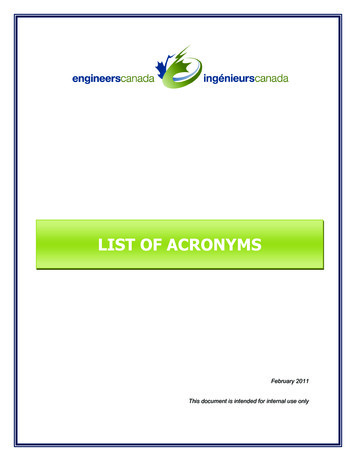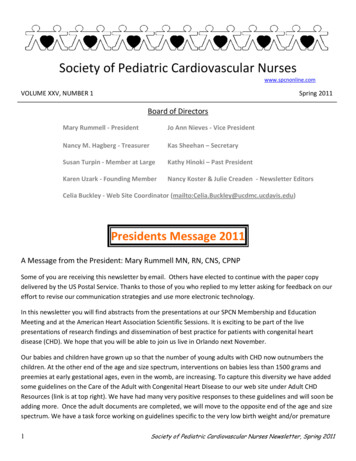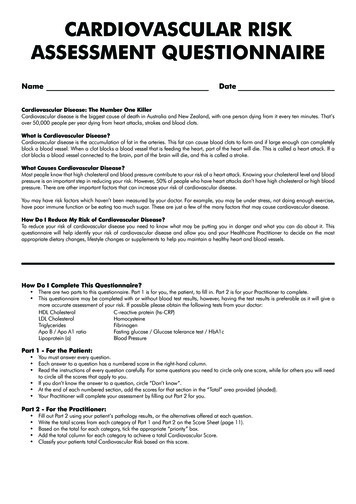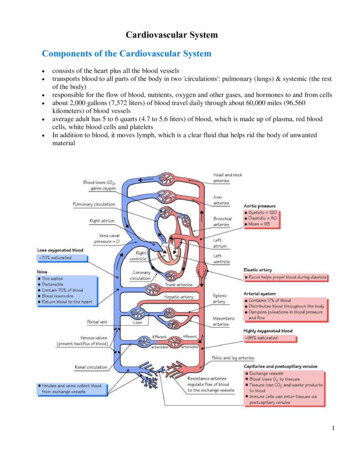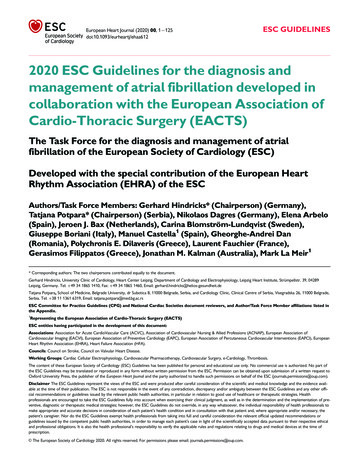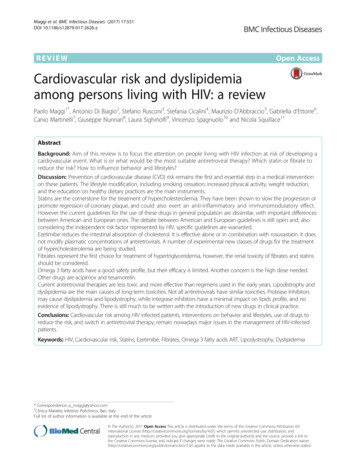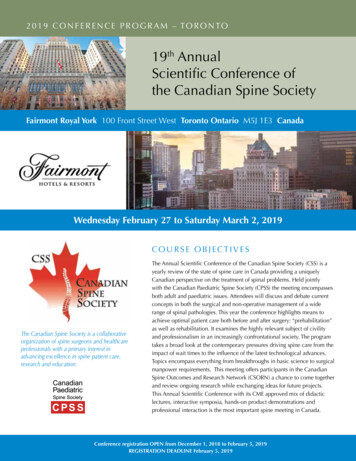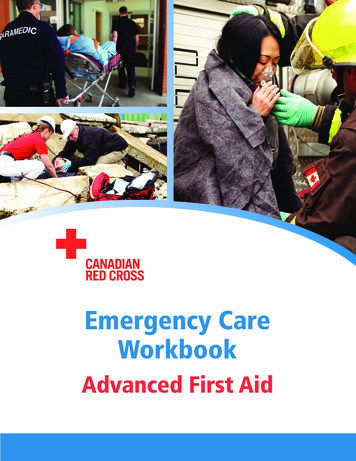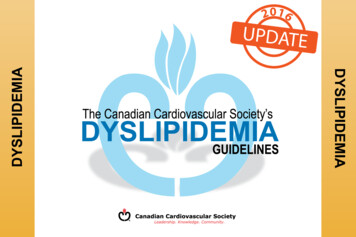
Transcription
2016DYSLIPIDEMIADYSLIPIDEMIADYSLIPIDEMIAUPDATE
About this Pocket GuideThis pocket guide is a quick-reference tool that features diagnostic and treatment recommendations based on the CCSDyslipidemia Guidelines (2006, 2009, 2012 and 2016).These recommendations are intended to provide a reasonable and practical approach to care for specialists, physiciansand allied health professionals. They are subject to change as scientific knowledge and technology advance andpractice patterns evolve, and are not intended to be a substitute for clinical judgement. Adherence to theserecommendations will not necessarily produce successful outcomes in every case.For information about the GRADE approach for rating the strength of recommendations and quality of evidence, visitwww.ccs.ca.Please visit www.ccs.ca for more information and additional resources.Co-ChairsTodd J. Anderson MD, Jean Grégoire MD and Glen J. Pearson PharmDCCS Dyslipidemia Guidelines Primary PanelArden Barry PharmD, Patrick Couture MD, Martin Dawes MD, Gordon A. Francis MD, Jacques Genest Jr MD, StevenGrover MD, Milan Gupta MD, Robert A. Hegele MD, David C. Lau MD, PhD, Lawrence A. Leiter MD, Eva Lonn MD, G.BJohn Mancini MD, Ruth McPherson MD, PhD, Daniel Ngui MD, Paul Poirier MD, PhD, John Sievenpiper MD, PhD,James A. Stone MD, PhD, George Thanassoulis MD, Richard Ward MD for the CCS Dyslipidemia GuidelinesCommittee.
Table of ContentsSummary of 2016 Guideline Changes and Highlights. 2ScreeningWho to screen and How to Screen. 3Secondary Testing. 5Risk AssessmentRisk Assessment for Primary Prevention . 6Risk Stratification . 7Primary and Secondary Lipoprotein Determinants. 8ManagementWhen to Consider Pharmacological Treatment . 9Targets of Therapy.12Potential Adverse Effects of Statins .14Non-Statin therapy.15Health Behaviour Interventions .17Approach to Risk Management (Algorithm) .21Follow-up and Referral to Specialist Clinics .23
Summary of 2016 Guideline Changes and HighlightsWhat’s new? Lipid screening for both men and women 40 years of age, and screening for women with a history of HDP (page 3) Non-fasting lipid determination recommendation (page 4) Risk assessment using FRS and CLEM (page 6) Broader treatment recommendations for those in intermediate risk category (includes statin indicated conditions) (page 9) Expanded definition of CKD as high-risk phenotype (page 9) New targets: LDL-C 2.0 mmol/L for individuals for whom treatment is initiated, or consider more aggressive targets ofLDL-C 1.8 mmol/L for recent ACS patients (page 13) New recommendations for non-statin drugs (page 15) Nutritional guidelines that focus on dietary patterns – Mediterranean, DASH or Portfolio diet (page 17) Detailed review of the impact of nutritional components on lipids and CV events (page 19)LDL-C – low density lipoprotein cholesterol; CKD – chronic kidney disease; DASH – Dietary Approaches to Stop Hypertension; HDP - Hypertensive disease of pregnancyKey Messages LDL-cholesterol levels are directly linked to the development of atherosclerosis and its reduction is directly linked tothe reduction in cardiovascular disease events Health behaviour modification remains a cornerstone of risk reduction2
5Who to Screen3Diabetes mellitusarcus cornealis***Men 55 and women 65 yrs of age in first degree relative**CKD: eGFR 60 ml/min/1.73 m2 or ACR 3 mg/mmol for at least 3 months durationScreening
How to ScreenLIPID TESTING CAN GENERALLY BE DONE NON-FASTINGRECOMMENDATION We recommend non-fasting lipid and lipoprotein testing can be performed in adults in whom screening is indicated as part of acomprehensive risk assessment to reduce CVD events (Strong Recommendation, High Quality Evidence). We suggest that for individuals with a history of triglyceride levels 4.5 mmol/L that lipid and lipoprotein levels be measuredfasting (Conditional Recommendation, Low Quality Evidence).Pratical Tip - Compared to fasting lipid values, there will be minimal change with non-HDL-C, a slight decrease in LDL-C andsmall increase in triglyceride concentrations when most individuals do not fast.Screening4
Secondary TestingCoronary Artery Calcium (CAC) Measurement - Recommendations We suggest that CAC screening using computed tomography imaging might be appropriate for asymptomatic, middle-aged adults (FRS 10-20%)for whom treatment decisions are uncertain (Conditional Recommendation, Moderate Quality Evidence). We suggest that CAC screening using computed tomography imaging might not be undertaken for a) high risk individuals b) patients receving statintreatment or c) most asymptomatic, low-risk adults (Strong Recommendation, Moderate Quality Evidence). We suggest that CAC screening might be considered for a subset of low-risk middle-aged individuals with a family history of premature CHD (men 55 years; women 65 years) (Conditional Recommendation, Low Quality Evidence). We suggest that in patients who warrant risk factor management on the basis of usual criteria, CAC scoring not be undertaken. Moreover, CACscoring (seeking a result with a value of zero) should not be used as a rationale for withholding otherwise indicated, preventive therapies (Strongrecommendation, Low Quality Evidence).Lipoprotein (a) Measurement - Recommendation We suggest that Lp(a) might aid risk assessment in subjects at intermediate Framingham risk or with a family history of premature coronary arterydisease (Conditional Recommendation, Moderate Quality Evidence).Values and preferences - Lp(a) is a marker of CVD risk. Particular attention should be given to individuals with Lp(a) levels above 30mg/dL forwhom CVD risk is increased by approximately twofold. Although no randomized clinical trials are available to support basing treatment decisionssolely on an elevated LP(a) level, identification of high levels of Lp(a) might be particularly useful for mutual decision-making in intermediate-risksubjects. Moreover, in younger patients who have a very strong family history of premature CVD suspected to be related to atherogenic dyslipidemiabut who by virtue of young age, do not meet usual risk criteria for treatment, detection of high Lp(a) might help inform mutual decision makingregarding treatment. Lp(a) is not considered a treatment target and repeat measures are not indicated.Screening5
Risk Assessment for Primary PreventionCalculate risk (unless statin-indicated condition) using the Framingham Risk Score (FRS) or Cardiovasular Life Expectancy Model (CLEM) Repeat screening every 5 years for FRS 5% or every year for FRS 5%RECOMMENDATIONS We recommend that a cardiovascular risk assessment be completed every 5 years for men and women age 40 to 75 using themodified FRS or CLEM to guide therapy to reduce major cv events. A risk assessment may also be completed whenever apatient’s expected risk status changes (Strong Recommendation, High Quality Evidence). We recommend sharing the results of the risk assessment with the patient to support shared decision making and improve thelikelihood that patients will reach lipid targets (Strong Recommendation, High Quality Evidence).Pratical Tip - While there is good evidence to support the use of statins in secondary prevention in patients over the age of 75years for some outcomes, a mortality benefit has not been demonstrated. In addition, the evidence for statin use in primaryprevention is lacking in this population, mainly because they have not been extensively studied. For robust elderly patientsbelieved to be at higher risk, a discussion about the importance of statin therapy in overall management should be undertakenas these patients are often at high risk because a CVD event has important consequences for morbidity. Can calculate Cardiovascular Age with the Cardiovascular Life Expectancy Model at: www.chiprehab.comFor mobile device applications from the CCS, please visit: www.ccs.caFRS calculator: myhealthcheckup.comRIsk Assessment6
Risk Stratification7Statins are first line therapy but add-on or alternative therapy may be required as per the algorithmRIsk Assessment
Primary and Secondary Lipoprotein DeterminantsLDL-C: Calculated from standard Lipid ProfileApo B: Measured separatelyChylomicronRemnantsVLDLVery High-densitylipoproteinNon-HDL-C Total Cholesterol-HDL-CAtherogenicApo B-containingLipoproteinsRECOMMENDATION We recommend that non-HDL-C and apo B should continue to be considered alternate targets to LDL-C to evaluate risk inadults (Strong Recommendation, High Quality Evidence).Values and preferences - As clinicians are most familiar with LDL-C we continue to recommend its use as the primary target,but recognize the advantages of non-HDL-C or apo B.RIsk Assessment8
When to Consider Pharmacological Treatment in Risk ManagementStatin-indicated ConditionsCLINICALATHEROSCLEROSISMyocardial infarction, acutecoronary syndromesStable angina, documentedcoronary disease by angiographyStroke, TIA, documentedcarotid diseasePeripheral artery disease,claudication and/or ABI 0.9ABDOMINAL AORTICANEURYSMAbdominal aorta 3.0 cmor Previous aneurysmsurgeryDIABETESMELLITUS 40 years of age or 15 years duration andage 30 years of age orMicrovascular complicationsCHRONIC KIDNEYDISEASELDL-C 5.0 MMOL/L 3 months duration andACR 3.0 mg/mmol oreGFR 60 ml/min/1.73m2 50 years of ageLDL-C 5.0 mmol/L orDocument familialhypercholesterolemiaExcluded 2nd causesRECOMMENDATIONStatin-indicated conditions: We recommend management that includes statin therapy in high risk conditions including clinical atherosclerosis, abdominal aorticaneurysm, most diabetes mellitus, chronic kidney disease (age 50 years) and those with LDL-C 5.0 mmol/L to decrease the riskof CVD events and mortality (Strong Recommendation, High Quality Evidence).Management9
When to Consider Pharmacological Treatment in Risk ManagementPrimary Prevention ConditionsFRS 10-19% and LDL-C 3.5 mmol/L orNon-HDL-C 4.3 mmol/L orApo B 1.2 g/L orMen 50 and women 60 with one additional riskfactor: low HDL-C, impaired fasting glucose,high waist circumference, smoker, hypertensionorRECOMMENDATIONPrimary prevention:a) We recommend management that does not include statin therapy for individuals at low risk (modified FRS 10 %) to decrease the risk of CVD events (StrongRecommendation, High Quality Evidence).b) We recommend management that includes statin therapy for individuals at high risk (modified FRS 20%) to decrease the risk of CVD events (Strong Recommendation, High Quality Evidence).c) We recommend management that includes statin therapy for individuals at intermediate risk (modified FRS 10-19%) with LDL-C 3.5 mmol/L to decrease the riskof CVD events. Statin therapy should also be considered for intermediate risk persons with LDL-C 3.5 mmol/L but with apo B 1.2 g/L or non-HDL-C 4.3 mmol/Lor in men 50 and women 60 years of age with 1 CV risk factor (Strong Recommendation, High Quality Evidence).Values and preferences - This recommendation applies to individuals with an LDL-C 1.8 mmol/L. Any decision regarding pharmacological therapy for CV riskreduction in IR persons needs to include a thorough discussion of risks, benefits, and cost of treatment, alternative nonpharmacological methods for CV riskreduction and each individual’s preference. The proportional risk reduction associated with statin therapy in RCTs in (IR) persons is of similar magnitude to thatattained in high-risk persons. Moreover, irreversible severe side effects are very rare and availability of generic statins results in low cost of therapy. However, theabsolute risk reduction is lower. Statin therapy may be considered in persons with FRS of 5%-9% with LDL-C 3.5 mmol/L or other CV risk factors as the proportionalbenefit from statin therapy will be similar in this group as well.Management10
Chronic Kidney Disease11RECOMMENDATIONS We recommend treatment with a statin or statin/ezetimibe combination to reduce CVD events in adults 50 years with chronic kidney disease nottreated with dialysis or a kidney transplant (Strong Recommendation, High Quality Evidence).Values and preferences - If the preference is to engage in early prevention and long-term risk reduction, in subjects 50 years the absolute risk ofevents is lower but studies suggest that statins will result in a relative risk reduction similar to those 50 years. The statin/ezetimibe combinationrecommendation is based on the SHARP study which utilized 20 mg of simvastatin and 10 mg of ezetimibe. We suggest that lipid-lowering therapy not be initiated in adults with dialysis-dependent CKD (Conditional Recommendation, Moderate QualityEvidence).Values and preferences - In younger individuals who may become eligible for kidney transplantation or with a longer life expectancy, statin or statin/ezetemibe combination therapy may be desirable although high-quality studies have not been done in this population. We suggest that lipid-lowering therapy be continued in adults already receiving it at the time of dialysis initiation (Conditional Recommendation, LowQuality Evidence).Values and preferences - This recommendation reflects that fact that a substantial number of patients in SHARP transitioned to dialysis during thestudy and there was no heterogeneity of results for the population as a whole. The evidence is of low quality overall and there is substantial debate aboutbest practice in this situation. We suggest the use of statin therapy in adults with kidney transplantation (Conditional Recommendation, Moderate Quality Evidence).Management
Pharmacological Treatment Indications and TargetsCategoryPrimary PreventionConsider Initiatingpharmaco-therapy if:TargetHigh(FRS 20%)NNT35LDL-C 2.0 mmol/L or 50%Intermediate(FRS 10-19%)LDL-C 3.5 mmol/Lor Non-HDL-C 4.3 mmol/Lor Apo B 1.2 g/Lor Men 50 and women 60 yrsand one additional CVD RFStatin IndicatedConditions**Clinical atherosclerosis*40OrApo B 0.8 g/LOr20Abdominal aortic aneurysmDiabetes mellitus 40 yrs 15 yrsduration for age 30 yrs (DM1)Microvascular diseasenon-HDL-C 2.6 mmol/LChronic kidney disease (age 50 y)eGFR 60 mL/min/1.73m2 or ACR 3 mg/mmolLDL-C 5.0 mmol/L 50% in LDL-CNNT: number needed to treat to prevent one CVD event for 5 years of treatment per 1 mmol/L reduction in LDL-C. NNT of 50 are generally regardedas desirable by physicians with some patients wishing to see NNT 30 to deem an intervention as acceptable.FRS – modified Framingham Risk Score; ACR – albumin:creatinine ratio;* consider LDL-C 1.8 mmol/L for subjects with ACS within last 3 months** statins indicated as initial therapyManagement12
Monitoring, Surveillance and Targets13RECOMMENDATIONS We recommend a treat-to-target approach in the management of dyslipidemia to mitigate CVD risk (Strong Recommendation, High QualityEvidence).Statin Indicated Conditions:a) We recommend a target LDL-C consistently 2.0 mmol/L or 50% reduction of LDL-C for individuals for whom treatment is initiated to decrease therisk of CVD events and mortality (Strong Recommendation, Moderate-Quality Evidence). Alternative target variables are apo B 0.8 g/L ornon-HDL-C 2.6 mmol/L (Strong Recommendation, Moderate Quality Evidence).b) We recommend a 50% reduction of LDL-C for patients with LDL-C 5.0 mmol/L in individuals for whom treatment is initiated to decrease the risk ofCVD events and mortality (Strong Recommendation, Moderate Quality Evidence).Values and preferences - Based on the IMPROVE-IT trial, for those with a recent acute coronary syndrome and established coronary disease consideration should be given to more aggressive targets (LDL-C 1.8 mmol/L or 50% reduction). This might require the combination of ezetimibe (or othernon-statin medications) with maximally tolerated statin. This would value more aggressive treatment in higher risk individuals.Primary prevention conditions warranting therapy (All risk groups): We recommend a target LDL-C consistently 2.0 mmol/L or 50% reduction of LDL-C in individuals for whom treatment is initiated to decrease therisk of CVD events (Strong Recommendation, Moderate Quality Evidence). Alternative target variables are apo B 0.8 g/L or non-HDL-C 2.6 mmol/L(Strong Recommendation, Moderate Quality Evidence).Values and preferences - According to evidence from randomized trials in primary prevention, achieving these levels will reduce CVD events. Themortality reduction is statistically significant but modest (NNT 250). Treatment in primary prevention values morbidity reduction preferentially.Management
Potential Adverse Effects of StatinsRECOMMENDATIONS We recommend that despite concerns about a variety of possible adverse effects, all purported statin-associated symptoms should be evaluatedsystematically, incorporating observation during cessation, re-initiation (same or different statin, same or lower potency, same or decreased frequencyof dosing) to identify a tolerated, statin-based therapy for chronic use (Strong Recommendation, Low Quality Evidence). We recommend that vitamins, minerals, or supplements for symptoms of myalgia perceived to be statin-associated not be used (StrongRecommendation, Low Quality Evidence).Values and preferences - Always confirm that there is an indication for statin use which, if present, would suggest that benefits, clearly communicatedto the patient, far outweigh the potential occurrence of any of the many side effects purported to be associated with statin use. Assess patient featuresthat might limit dosage or preclude use of statins (e.g. potential drug-drug interactions) and always emphasize dietary, weight and exercise interventionsto facilitate achievement of lipid goals and other benefits of comprehensive, CV prevention.Management14
Non-Statin Therapy15RECOMMENDATIONS We recommend ezetimibe as second-line therapy to lower LDL-C levels in patients with clinical CVD if targets are not reached with maximally toleratedstatin therapy (Strong Recommendation, High Quality Evidence). We recommend that niacin not be added to statin therapy for CVD prevention in patients who have achieved LDL-C targets (Strong Recommendation,High Quality Evidence).Values and preferences - It remains unclear whether niacin offers CV benefits in other patient groups, such as those with LDL-C above target or thosewith low HDL-C or high triglyceride levels. We recommend that fibrates not be combined with statin therapy for CVD event prevention in patients who have achieved LDL-C targets (Strongrecommendation, High Quality Evidence).Values and preferences - In sub-group analysis, patients with elevated triglycerides and low HDL-C may benefit from fibrate therapy.Management
Non-Statin TherapyRECOMMENDATIONS We suggest that bile acid sequestrants be considered for LDL-C lowering in high risk patients whose levels remain above target despite statintreatment /- ezetimibe therapy (Conditional Recommendation, Low Quality Evidence). We suggest the use of PCSK9 inhibitors (evolocumab, alirocumab) to lower LDL-C for patients with heterozygous familial hypercholesterolemia whoseLDL-C level remains above target despite maximally tolerated statin therapy (Conditional Recommendation, Moderate Quality Evidence). We suggestthat evolocumab be combined with background therapy in patients with homozygous familial hypercholesterolemia and continued if LDL-C lowering isdocumented (Conditional Recommendation, Moderate Quality Evidence). We suggest that PCSK9 inhibitors be considered to lower LDL-C for patients with atherosclerotic cardiovascular disease in those not at LDL-C goaldespite maximally tolerated statin doses /- ezetimibe therapy (Conditional Recommendation, Moderate Quality Evidence).Values and preferences - Definitive outcome trials with PCSK9 inhibitors are underway but have not yet been completed. However, phase 3 efficacytrials show consistent reduction in LDL-C and reassuring trends towards reduced CV events, even though they were not powered for such. Given thevery high lifetime risk faced by patients with familial hypercholesterolemia or ASCVD, clinicians should balance the anticipated benefits of robust LDL-Clowering with PCSK9 inhibitors against the lack of definitive outcomes data. We suggest lomitapide and mipomersen* may be considered exclusively in patients with homozygous familial hypercholesterolemia (ConditionalRecommendation, Moderate Quality Evidence).*not approved in CanadaManagement16
Treatment: Health Behaviour Interventions17Healthy Eating We recommend that all individuals are offered advice about healthy eating and activity and adopt the Mediterranean dietary pattern to decrease theirCVD risk (Strong Recommendation, High Quality Evidence).Values and preferences - Adherence is one of the most important determinants for attaining the benefits of any diet. Individuals should choose thedietary pattern that best fits with their values and preferences, allowing them to achieve the greatest adherence over the long term. We recommend that omega-3 polyunsaturated fatty acids (PUFAs) supplements not be used to reduce CVD events (Strong Recommendation,High Quality Evidence).Values and preferences - Although there is no apparent cardiovascular benefit, patients may choose to use these supplements for other indicationsincluding the management of high triglycerides. Individuals should be aware that there are different preparations of long chain omega-3 PUFAs high indocosahexaenoic acid (DHA) and eicosapentaenoic (EPA) acid from marine, algal, and yeast sources and that high doses are required (2-4 g/day). We suggest that individuals avoid the intake of trans fats and decrease the intake of saturated fats for CVD disease risk reduction (ConditionalRecommendation, Moderate Quality Evidence). We suggest that to increase the probability of achieving a cardiovascular benefit, individuals should replace saturated fats with polyunsaturated fats(Conditional Recommendation, Moderate Quality Evidence), emphasizing those from mixed omega-3/omega-6 PUFAs sources (e.g. canola andsoybean oils) (Conditional Recommendation, Moderate Quality Evidence), and target an intake of saturated fats of 9% of total energy (ConditionalRecommendation, Low Quality Evidence). If saturated fats are replaced with mono-unsaturated fatty acids (MUFAs) and carbohydrates, then peopleshould choose plant sources of MUFAs (e.g. olive oil, canola oil, nuts, and seeds) and high-quality sources of carbohydrates (e.g. whole grains and lowglycemic index carbohydrates) (Conditional Recommendation, Low Quality Evidence).CVD: cardiovascular disease.Management
Treatment: Health Behaviour InterventionsHealthy Eating - ContinuedValues and preferences - Industrial trans fats are no longer generally regarded as safe (GRAS) in the United States and there are monitoring efforts aimed at reducing them tothe lowest level possible in Canada. These conditions make it increasingly difficult for individuals to consume trans fats in any appreciable amount. Individuals may choose toreduce or replace different food sources of saturated fats in the diet, recognizing that some food sources of saturated fats, such as milk and dairy products and plant-basedsources of saturated fats, have not been reliably associated with harm. We suggest that all individuals be encouraged to moderate energy (caloric) intake to achieve and maintain a healthy body weight (Conditional Recommendation,Moderate-Quality Evidence) and adopt a healthy dietary pattern to lower their CVD risk:(a)(b)(c)(d)(e)(f)(g)(h)Mediterranean dietary pattern (Strong Recommendation, High Quality Evidence)Portfolio dietary pattern (Conditional Recommendation, Moderate Quality Evidence)DASH dietary pattern (Conditional Recommendation, Moderate Quality Evidence)Dietary patterns high in nuts ( 30 g/day) (Conditional Recommendation, Moderate Quality Evidence)Dietary patterns high in legumes ( 4 servings/week) (Conditional Recommendation, Moderate Quality Evidence)Dietary patterns high in olive oil ( 60 mL/day) (Conditional Recommendation, Moderate Quality Evidence)Dietary patterns rich in fruits and vegetables ( 5 servings/day) (Conditional Recommendation, Moderate Quality Evidence)Dietary patterns high in total fibre ( 30 g/day) (Conditional Recommendation, Moderate Quality Evidence) and whole grains ( 3 servings/day) (Conditional Recommendation, Low-Quality Evidence)(i) Low-glycemic load (GL) (Conditional Recommendation, Moderate Quality Evidence) or low-glycemic index (GI) (Conditional Recommendation, Low Quality Evidence) dietarypatterns(j) Vegetarian dietary patterns (Conditional Recommendation, Very Low Quality Evidence)Values and preferences - Adherence is one of the most important determinants for attaining the benefits of any diet. High food costs (e.g. fresh fruits and vegetables), allergies(e.g. peanut and tree nut allergies), intolerances (e.g. lactose intolerance), and gastrointestinal (GI) side effects (e.g. flatulence and bloating from fibre) may present as importantbarriers to adherence. Other barriers may include culinary (e.g. ability and time to prepare foods), cultural (e.g. culturally specific foods), and ecological/environmental (e.g.sustainability of diets) considerations. Individuals should choose the dietary pattern that best fits with their values and preferences, allowing them to achieve the greatestadherence over the long term.CVD: cardiovascular disease.Management18
Treatment: Health Behaviour Interventions19Healthy Eating - Continued We suggest the following dietary patterns for LDL-C lowering:(a) Dietary patterns high in dietary pulses ( 1 serving/day or 130 g/day) (beans, peas, chickpeas, and lentils) (Conditional Recommendation, ModerateQuality Evidence)(b) Low GI dietary patterns (Conditional Recommendation, Moderate Quality Evidence)(c) DASH dietary pattern (Conditional Recommendation, Moderate Quality Evidence) We recommend the following dietary components for LDL-C lowering:(a) Portfolio dietary pattern (Strong Recommendation, High Quality Evidence)(b) Dietary patterns high in nuts ( 30 g/day) (Strong Recommendation, High Quality Evidence)(c) Dietary patterns high in soy protein ( 30 g/day) (Strong Recommendation, High Quality Evidence)(d) Dietary patterns with plant sterols/stanols ( 2 g/day) (Strong Recommendation, High Quality Evidence)(e) Dietary patterns high in viscous soluble fibre from oats, barley, psyllium, pectin, or konjac mannan ( 10 g/day) (Strong Recommendation, High QualityEvidence)(f) US NCEP Step I and II dietary patterns (Strong Recommendation, High Quality Evidence)Values and preferences - Individuals may choose to use an LDL-C lowering dietary pattern alone or as an add-on to lipid-lowering therapy to achievetargets. Dietary patterns based on single-food interventions (high plant sterols/stanols, viscous soluble fibre, nuts, soy, dietary pulses) may be consideredadditive (that is, the 5-10% LDL-C lowering effect of each food can be summed) based on the evidence from the Portfolio dietary pattern.Management
Treatment: Health Behaviour InterventionsActivity We recommend that adults should accumulate at least 150 minutes of moderate-to-vigorous intensity aerobic physical activity per week, in bouts of 10minutes or more to reduce CVD risk (Strong Recommendation, High Quality Evidence).Smoking Cessation We recommend that adults who smoke should receive clinician advice to stop smoking to reduce CVD risk (Strong Recommendation, High QualityEvidence).Facilitators for Change We recommend combining low-risk lifestyle behaviors that include achieving and maintaining a healthy body weight, healthy diet, regular physicalactivity, moderate alcohol consumption, and moderate sleep duration to achieve maximal CVD risk reduction (Strong Recommendation, High QualityEvidence).Values and preferences - Low risk lifestyle behaviours are variably defined as follows: a healthy body weight (BMI 18.5-25 to 30kg/m2 or waistcircumference of 88 cm for women or 95 to 102 cm for men), healthy diet (higher fruits & vegetables to Mediterranean dietary pattern), regular physicalactivity ( 1 time/week to 40 min/day plus 1 hour/week of intense exercise), smoking cessation (never smoked to smoking cessation 12 months),moderate alcohol consumption ( 12-14g/month to 46 g/day), and moderate sleep duration (6 to 8hours/night). Individuals can achieve benefits in adose-dependent manner.CVD: cardiovascular disease.We recognize that lifestyle changes are not easy to ach
Summary of 2016 Guideline Changes and Highlights 2 Lipid screening for both men and women 40 years of age, and screening for women with a history of HDP (page 3) Non-fasting lipid determination recommendation (page 4) Risk assessment using FRS and CLEM (page 6) Broader treatment recommendations for those in intermediate risk category (includes statin indicated conditions .
